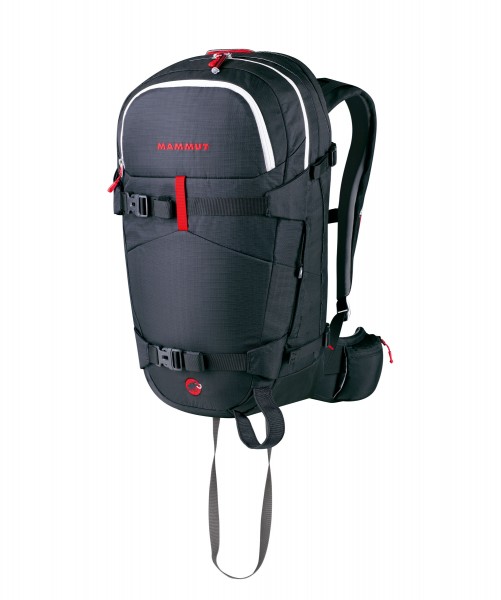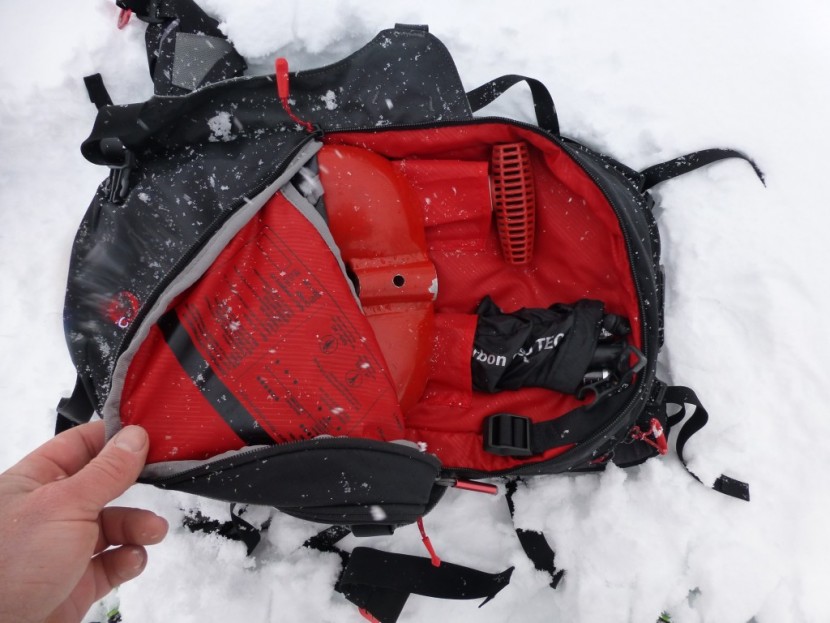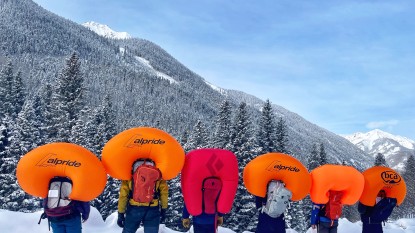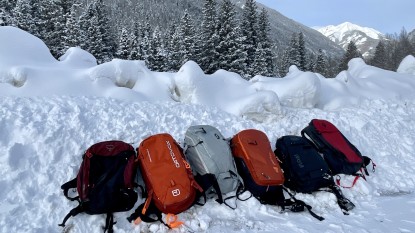Mammut Ride Removable 3.0 Review
Our Verdict
Our Analysis and Test Results
Airbag System
The Ride Removable system features a single, 150L bag with a fairly standard size and rectangular shape. While it doesn't cradle your neck and head for extra protection, or offer double bags for redundancy, there are very few reports of this type of straightforward, single bag failing.
The RAS: Removable Airbag System
This system allows you to buy one airbag/canister system that is compatible with multiple packs. Each pack sells for around $280.
Trigger MechanismABS packs have a trigger that you can move from one shoulder strap to the other. This one is fixed on the left side. Don't fret; we don't consider this a significant drawback. The trigger mechanism isn't our favorite, but we found it reliable.
Travel ConsiderationsTSA and the FAA don't let you fly with empty nitrogen canisters, but they will allow you to check an empty compressed air canister. Keep the canister box to pack it for travel. It answers a lot of TSA's questions all on its own.
Comfort
The Ride Removable Airbag 3.0 runs on the short side relative to the other airbag packs we tested. Mammut uses high-quality foam and an awesome articulation in the shoulder straps and waist belt, giving one of the better fits in our review. We also like the frame in this pack; it transferred the load to the waist belt fantastically well. The Arc'teryx Voltair 30, Black Diamond Halo 28, and Black Diamond Saga 40 are all a perfect 10 out of 10 in this category.
Backcountry Utility
The Ride Removable looks like most “normal” ski packs with a fleece-lined goggle pocket and small zipped space for keys and other small stuff. The snow safety section is nicely organized but small. It will fit everything you need, as long as your shovel handle or probe isn't too long. We appreciate the removal nature of the airbag. It lets you drop a pound and a half for low danger spring skiing, or you can use it as a normal daypack.
Heavy-duty fabrics, thoughtful reinforcements, and hardy zippers make for a durable pack. We also liked that it had not only the metal waist belt buckle that nearly all airbag packs use but also had metal buckles on shoulder straps, taking one more step to make sure it doesn't get ripped off you.
Some small downsides to the Mammut Ride Removable Airbag are that it has no waist belt pockets and the airbag system eats into the pack volume. This pack felt a little more spacious than the Black Diamond Pilot 11, but not nearly as big as the BD Saga 40 or the Backcountry Access Float 32. Top scorers in this category include the Arc'teryx Voltair 30 (10/10), the Backcountry Access Float 32, and the Backcountry Access Float 42.
Carry Skis/Snowboard
The Ride Removable 3.0 is among the best packs to carry a traditional snowboard, being just a little bit better than the Arc'teryx Voltair 30. For skiers who like A-framing their skis, the Mammut Ride Removable Airbag excels at this and is one of the few packs smaller than 40L to offer this feature (thought the Mammut Pro Protection also offers capability). While there is some debate as to whether carrying them in this style possibly affects airbag deployment, the Ride Removable Airbag gives you the option for those lower angle approaches or rocky booters. The Ride Removable was average at carrying skis diagonally, with a simple yet effective strap system that did an exceptional job of keeping the skis snug, keeping them from slipping down after long booters. Attaching skis was quick and easy.
Downhill Performance
The performance on the down is basically each pack's “rideability”. We thought the back panel and Y-shaped support stay offered a nice combination of freedom of movement and support, but the Mammut Ride Removable Airbag did have one drawback. It has a large profile and can feel awkward. The subpar shoulder straps are reasonably sized but they aren't the most comfortable. The rideability and the small safety gear pocket were items that kept it from winning an award, earning it an 8 out of 10 for this metric. Contenders that came out on top in terms of downhill performance include the Arc'teryx Voltair 30, BD Halo 28, Backcountry Access Float 22, and Mammut Light Removable 3.0.
Weight
At around 6 and a half pounds, the Ride Removable Airbag is easily on the lighter side of airbag packs on the market. It is around half a pound lighter than either the Black Diamond Halo 28 JetForce (7 lbs 7oz), Arc'teryx Voltair (7 lbs 9 oz), or the Black Diamond Saga 40 JetForce (7 lbs 10 oz) and still around a half pound lighter than the Backcountry Access Float 32. If you want an airbag as light as they come make sure to check out the Mammut Light Removable 3.0 which at 5 lbs 6 oz is still a pound and a lighter, though it has fewer features.
Value
The cost of airbag packs can be confusing because some manufacturers include the cartridge in the price and some don't. With the Ride Removable Airbag 3.0, the pack is $600 and the canister is sold separately ($190 for the canister). Additional packs cost around $250. The Mammut Ride Removable is significantly less expensive than packs featuring ABS or battery powered fans. For example, the similar volume BD Halo 28 ($1100) and Arc'teryx Voltair 30 ($1300) are close to double the price and because of the ability to buy Ready models you can buy 2-3 Mammut airbag packs for the price of one battery powered pack.
The Bottom Line
While the Mammut Ride Removable 3.0 wasn't an award winner our entire review staff still think its an exceptionally solid pack, especially for the price. While it doesn't have any particularly unique features, it does have all the features more people want in an airbag/touring pack all for 8-16 ounces less than many other models. We think it's one of the more comfortable airbag packs and we love that Mammut offers so many different models that are airbag “Ready” for around $250 that allows folks who want a quiver of packs to do so without breaking the bank.







